Scottish Schools Adolescent Lifestyle and Substance Use Survey (SALSUS): Drug Use Report 2015
This report presents the drugs findings from the 2015 wave of the Scottish Schools Adolescent Lifestyle and Substance Use Survey (SALSUS).
This document is part of a collection
6 Risk and protective factors
Family
A number of aspects of family life were associated with drug use in the month before the survey. These were: who you live with; maternal awareness; paternal awareness; and family communication (Figure 6.1).
Who you live with
Among 13 year olds there were no differences in drug use in the last month by family status. However, among 15 year olds, those living with a single or step parent were more likely to have used drugs in the last month than those who lived with both parents.
Maternal and paternal awareness
Among both age groups, drug use in the last month was higher among those who thought that their mother knew a below average amount about what they do and who they are with. The same pattern emerged for father's perceived knowledge of activities, although to a lesser degree.
Family communication
Across both age groups, those that say they would be likely to talk to their family if they felt worried about something, were less likely to have taken drugs in the last month than those who would not.
Caring responsibilities
Those with caring responsibilities were slightly more likely to have used drugs in the last month than those who did not.
Figure 6.1 Proportion of pupils who took drugs in the last month by factors relating to family life (2015)
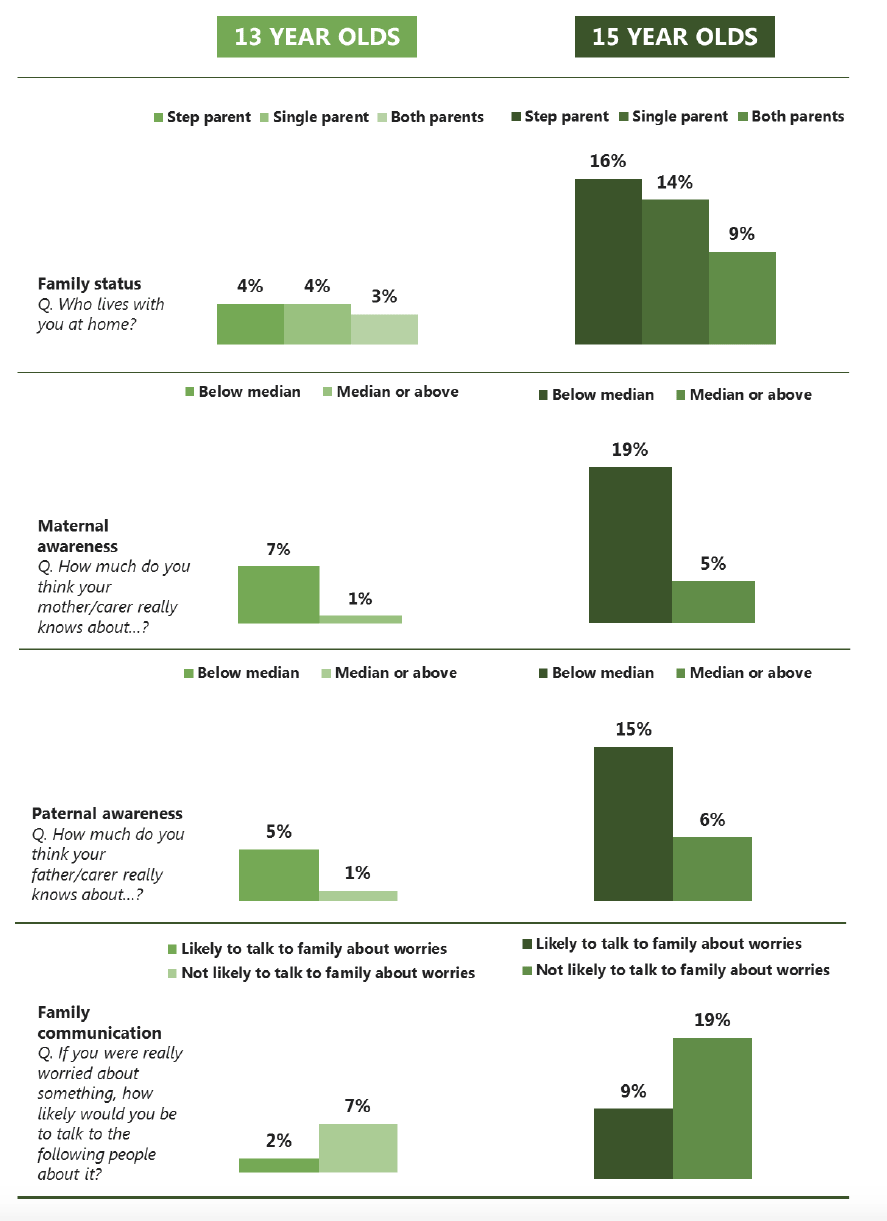
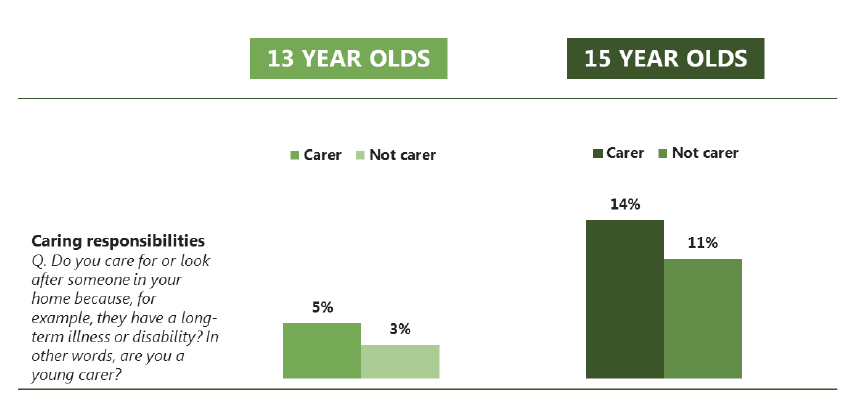
Base: all pupils (for full base sizes please see Appendix B)
Friends and leisure activities
Aspects of a pupil's social life were also associated with having used drugs in the last month. These were: number of close friends; age of friends; number of evenings spent out with friends; amount of own cash to spend; and type of leisure activities pursued (Figure 6.2).
Number of friends
Pupils with no close friends were more likely to have used drugs in the last month than those who had one or more.
Age of friends
Pupils with mostly older friends were more likely to have used drugs in the last month than those who had younger friends or friends about the same age. Among 15 year olds, having friends of mixed ages was also associated with a higher likelihood of using drugs in the last month but this was not the case among 13 year olds.
Number of evenings spent out with friends
The greater the number of evenings pupils spent out with friends in a week, the greater the likelihood that they had used drugs in the last month.
Amount of own cash to spend
Pupils with more money of their own to spend were more likely to have used drugs in the last month.
Leisure activities
Lower drug use prevalence was associated with spending time reading books. Among 13 year olds, playing a sport regularly and among 15 year olds doing a hobby regularly were also associated with lower levels of drug use.
In contrast, hanging out in the street and going to concerts or gigs regularly were associated with higher prevalence of drug use. Among 15 year olds, those that went to a friend's house on a weekly basis were more likely to have used drugs in the last month (Figure 6.3).
Figure 6.2 Proportion of pupils who took drugs in the last month by factors relating to friendships (2015)
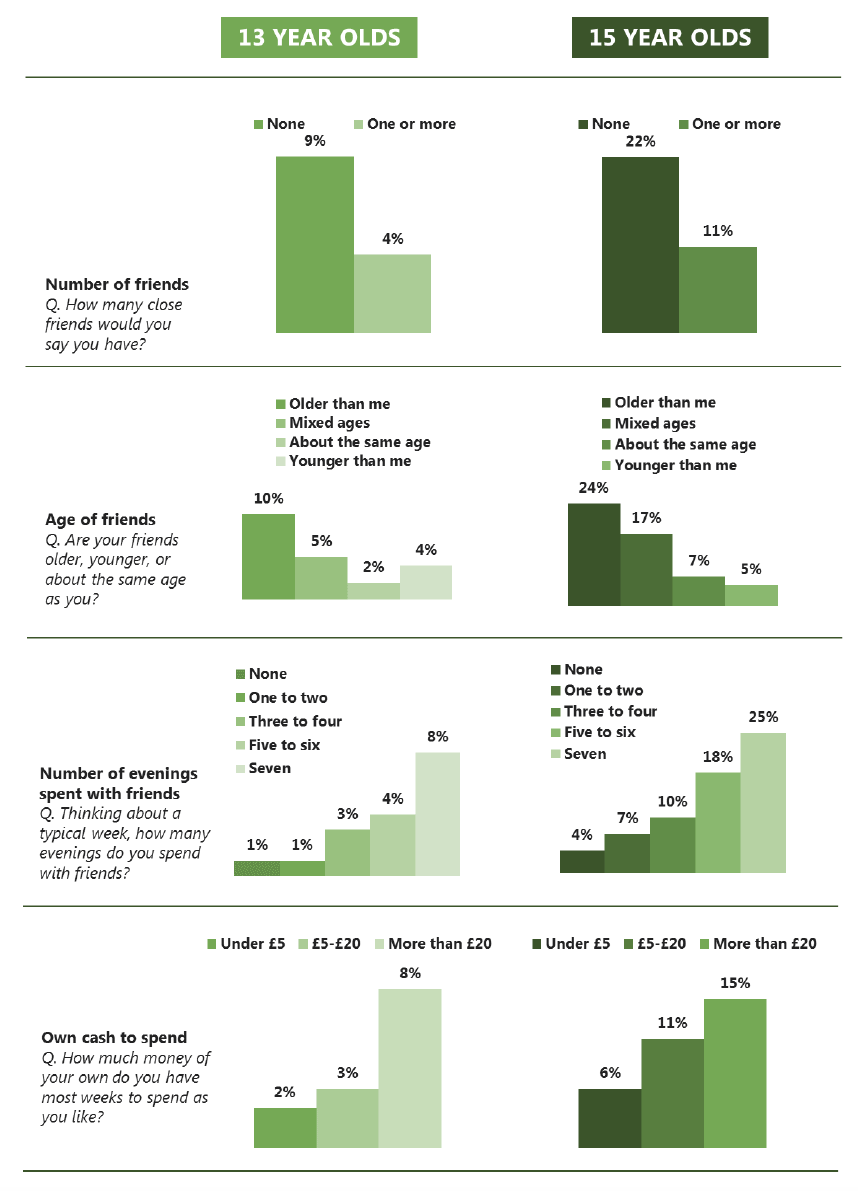
Base: all pupils (for full base sizes please see Appendix B)
Figure 6.3 Drug use in the last month, by weekly activities in order of strength of association (2015)
Q. Here is a list of things that young people sometimes do in their free time, when they aren't at school. What about you?
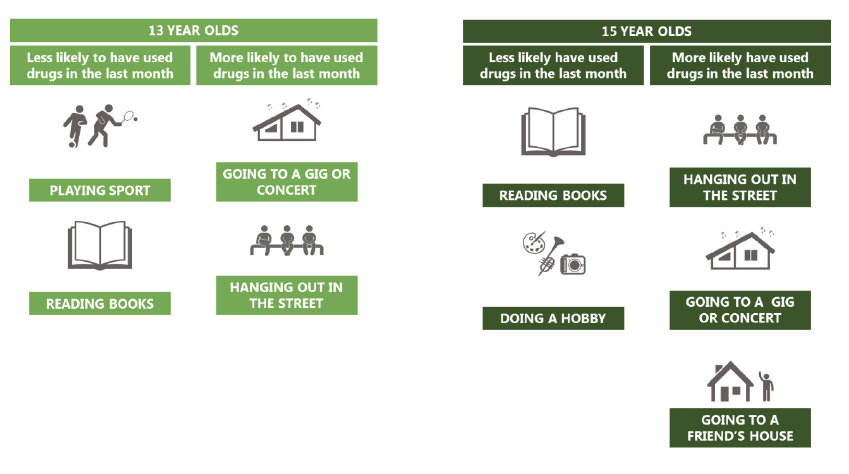
Base: all pupils (for full figures and base sizes please see Appendix B)
School
Factors relating to a pupil's engagement with school had a strong relationship with drug use behaviour. The more engaged a pupil was with school the less likely they were to have used drugs in the last month. The main factors were: enjoying school; feeling pressured by schoolwork; exclusion from school; and truanting. Post-school expectations were also related to drug use in the last month (Figure 6.4).
Enjoying school
The more a pupil liked school, the less likely they were to have used drugs in the last month.
Feeling pressured by schoolwork
At age 13 those who felt pressured by schoolwork a lot of the time were substantially more likely to have used drugs in the last month than those who never or only sometimes felt pressured.
However, among 15 year olds, it was those who never felt pressured who were most likely to have used drugs in the last month.
Exclusion from school
Pupils who had ever been excluded from secondary school were more likely to have used drugs in the last month than those who had not. 13 year olds who had been excluded were four times more likely to have used drugs in the last month, while 15 year olds who had been excluded were three times as likely.
Truanting
Truancy was strongly correlated with drug use in the last month. Among both age groups, the more frequently a pupil truanted, the more likely they were to have used drugs in the last month.
Post-school expectations
Among both age groups (although to a lesser extent at age 13), those that said they expected to go to university after school were less likely to have reported using drugs in the last month. Among 15 year olds, drug use in the last month was particularly prevalent among those who thought they would complete an apprenticeship after they leave school.
Figure 6.4 Proportion of pupils who used drugs in the last month by school variables (2015)
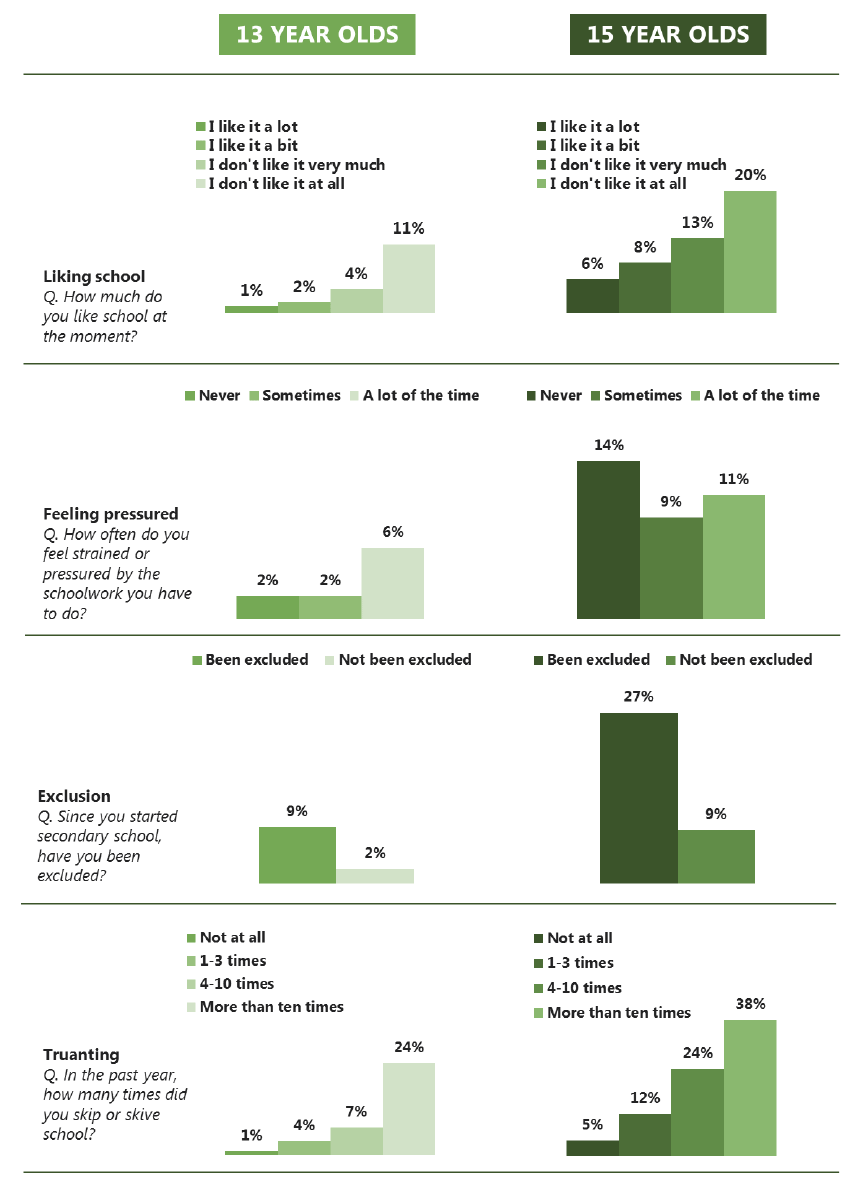
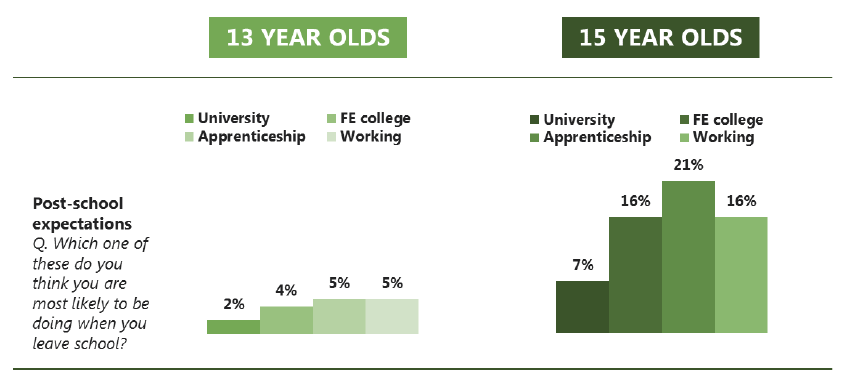
Base: all pupils (for full base sizes please see Appendix B)
Inequalities
Inequalities related to health and wellbeing had a stronger relationship with drug use in the last month than deprivation. The main factors were: self-rated health; whether a pupil had an illness or disability; emotional and behavioural problems; and mental wellbeing (Figure 6.5).
Self-rated health
Among both age groups, pupils who rated their health as 'bad' were more likely to have used drugs in the last month than those who rated their health as 'good'.
Illness or disability
Pupils who said they had a long-term illness or disability were more likely to have used drugs in the last month than those who did not.
Emotional and behavioural problems
Emotional and behavioural problems are assessed through the Strengths and Difficulties Questionnaire ( SDQ) in SALSUS. The questionnaire contains 5 scales: emotional problems, conduct problems, hyperactivity problems, peer problems and pro-social behaviour. The SDQ score is a composite measure derived from the first 4 scales listed and provides an overall indicator of emotional and behavioural problems.
Pupils with poorer scores for emotional wellbeing and behavioural conduct were more likely to have used drugs in the last month.
Mental Wellbeing
Mental wellbeing is assessed in SALSUS using the Warwick-Edinburgh Mental Well-being Scale ( WEMWBS). This is a scale of 14 positively worded items, with five response categories per item. The scale is scored by summing the response to each item answered on a 1 to 5 Likert scale. The minimum scale score is 14 and the maximum is 70. The higher a respondent's score, the better their mental wellbeing.
Among both age groups, those with below average score for mental wellbeing were more likely to have used drugs in the last month than those with an average or above average score.
Deprivation [7]
Area-based deprivation is assessed using the Scottish Index of Multiple Deprivation ( SIMD). This is used to provide an indication of material disadvantage in individual pupils.
Among 15 year olds, those living in the most deprived areas ( SIMD 1) were more likely to have used drugs in the last month than those living in more affluent areas. However, among 13 year olds, there was no relationship between using drugs in the last month and SIMD.
Figure 6.5 Proportion of pupils who used drugs in the last month by inequalities and age (2015)
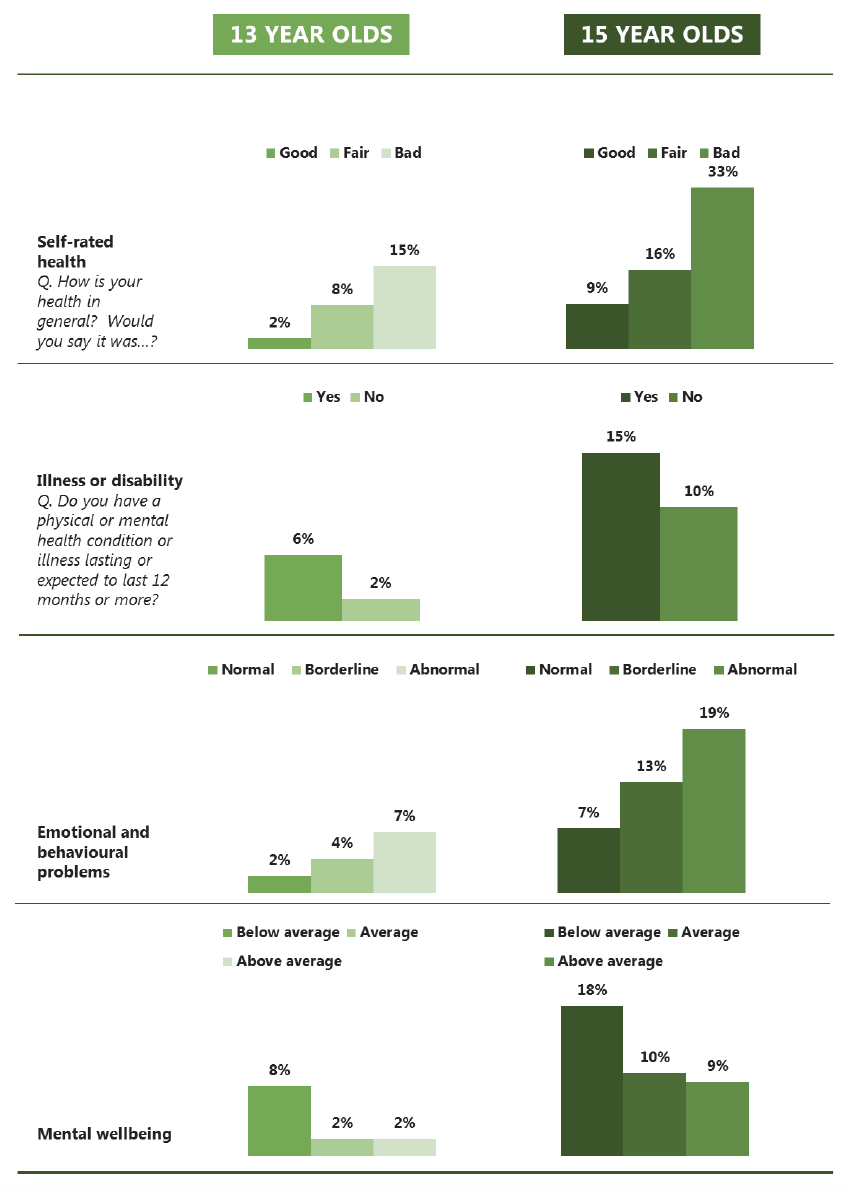
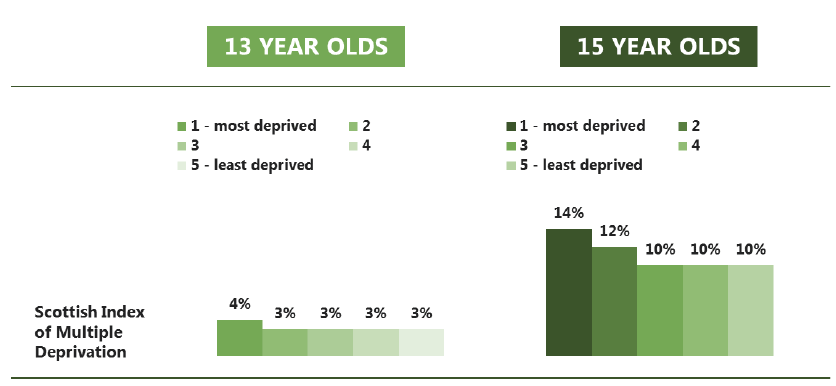
Base: all pupils (for full base sizes please see Appendix B)
Contact
There is a problem
Thanks for your feedback